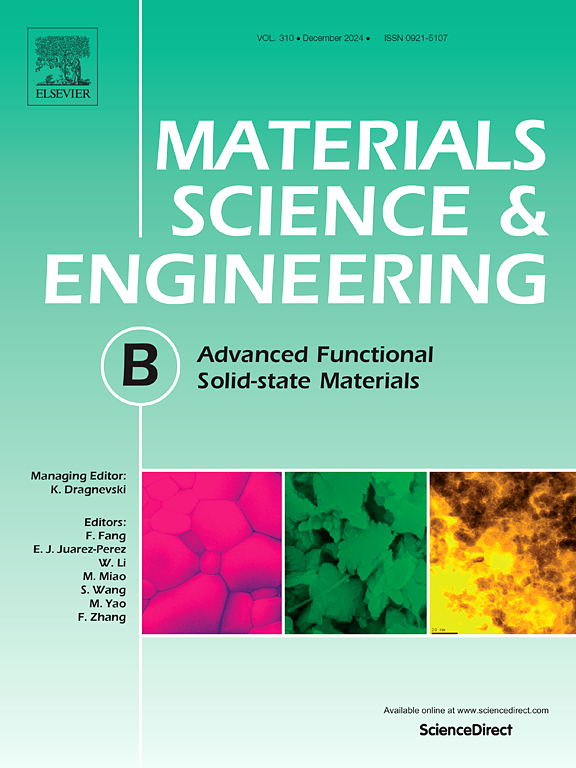通过在Mo和Sb2S3界面上集成MoS2层来提高开路电压(Voc)
IF 4.6
3区 材料科学
Q2 MATERIALS SCIENCE, MULTIDISCIPLINARY
引用次数: 0
摘要
在这项工作中,采用射频溅射沉积的Sb2S3作为前驱体层,制备了衬底结构的Sb2S3太阳能电池。这种沉积方法在硫系锑光伏研究中还相对未被探索。我们的研究结果表明,在溅射沉积前体Sb2S3的结晶过程中会出现双层结构,导致形态缺陷,这对器件的整体性能有害。这种双层结构在厚度为1微米或以上的吸收器中特别明显,在较薄的层中变得难以区分。此外,我们还研究了在吸收器和背触点之间加入薄二硫化钼界面层的影响。MoS2的界面层显著提高了开路电压(Voc),达到478 mV的最高值,而没有MoS2层的器件仅为93 mV。二硫化钼还促进了Sb2S3的首选晶体取向(hk1),提高了电荷收集效率。通过紫外和x射线光电子能谱分析,我们发现Mo不适合用于Sb2S3溅射太阳能电池,并且在MoS2的存在下,价带偏移明显减小。我们的研究结果强调了MoS2界面层在提高器件性能和优化Sb2S3太阳能吸收器晶体质量方面的关键作用。本文章由计算机程序翻译,如有差异,请以英文原文为准。
Open-circuit voltage (Voc) enhancement through integration of MoS2 layer at the interface between Mo and Sb2S3
In this work, Sb2S3 solar cells in a substrate configuration were fabricated using RF sputter-deposited Sb2S3 as the precursor layer. This deposition method remains relatively unexplored in antimony chalcogenide photovoltaic research. Our findings reveal that a double-layer structure can emerge during the crystallization of sputter-deposited precursors Sb2S3, resulting in morphological defects that are detrimental to the device’s overall performance. This double-layer structure is particularly pronounced in absorbers with a thickness of 1 µm or above and becomes indistinguishable in thinner layers. Furthermore, we examine the impact of incorporating a thin MoS2 interfacial layer between the absorber and the back contact. This interfacial layer of MoS2 significantly improves the open-circuit voltage (Voc), reaching the highest value of 478 mV, compared to just 93 mV for devices without the MoS2 layer. The MoS2 also facilitates a preferred crystal orientation (hk1) of Sb2S3, improving charge collection efficiency. Using combined ultraviolet and X-ray photoelectron spectroscopy, we show that Mo is not suitable for Sb2S3 sputtered solar cells, and the valence band offset is significantly reduced in the presence of MoS2. Our findings underscore the crucial role of the MoS2 interfacial layer in improving device performance and optimizing the crystalline quality of Sb2S3 solar absorbers.
求助全文
通过发布文献求助,成功后即可免费获取论文全文。
去求助
来源期刊

Materials Science and Engineering: B
工程技术-材料科学:综合
CiteScore
5.60
自引率
2.80%
发文量
481
审稿时长
3.5 months
期刊介绍:
The journal provides an international medium for the publication of theoretical and experimental studies and reviews related to the electronic, electrochemical, ionic, magnetic, optical, and biosensing properties of solid state materials in bulk, thin film and particulate forms. Papers dealing with synthesis, processing, characterization, structure, physical properties and computational aspects of nano-crystalline, crystalline, amorphous and glassy forms of ceramics, semiconductors, layered insertion compounds, low-dimensional compounds and systems, fast-ion conductors, polymers and dielectrics are viewed as suitable for publication. Articles focused on nano-structured aspects of these advanced solid-state materials will also be considered suitable.
 求助内容:
求助内容: 应助结果提醒方式:
应助结果提醒方式:


